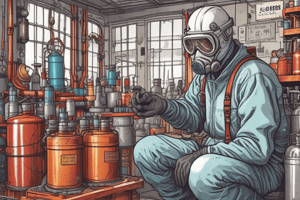Podcast
Questions and Answers
Which of the following is a dangerous property of hazardous chemicals?
Which of the following is a dangerous property of hazardous chemicals?
- Color
- Odor
- Flammability (correct)
- Viscosity
What are the acute health effects of hazardous chemicals?
What are the acute health effects of hazardous chemicals?
- Muscle cramps, blurred vision, rash
- Nausea, coughing, sneezing
- Headache, Fatigue, drowsiness (correct)
- Joint pain, Allergy, fever
Which class of hazardous chemicals may cause damage to the liver, kidneys, and central nervous system upon long-term exposure?
Which class of hazardous chemicals may cause damage to the liver, kidneys, and central nervous system upon long-term exposure?
- Compressed Gases
- Aliphatic HCs
- Asbestos-containing Materials
- Aromatic HCs (correct)
What category of hazardous chemicals includes substances that can cause cancer and reproductive disorders?
What category of hazardous chemicals includes substances that can cause cancer and reproductive disorders?
What is the chemical reaction representing the property of flammability?
What is the chemical reaction representing the property of flammability?
Explain the difference between acute effects and chronic effects of hazardous chemicals and provide examples of each type of effect.
Explain the difference between acute effects and chronic effects of hazardous chemicals and provide examples of each type of effect.
List the special classes of hazardous chemicals mentioned in the text and briefly describe the hazards associated with each class.
List the special classes of hazardous chemicals mentioned in the text and briefly describe the hazards associated with each class.
Provide examples of dangerous properties of hazardous chemicals and explain the potential risks associated with each property.
Provide examples of dangerous properties of hazardous chemicals and explain the potential risks associated with each property.
What is the chemical equation provided in the text to represent the property of flammability? Explain the significance of this equation.
What is the chemical equation provided in the text to represent the property of flammability? Explain the significance of this equation.
Discuss the chronic health effects of hazardous chemicals and provide examples of specific health hazards associated with long-term exposure.
Discuss the chronic health effects of hazardous chemicals and provide examples of specific health hazards associated with long-term exposure.
What are the four dangerous properties of hazardous chemicals mentioned in the text?
What are the four dangerous properties of hazardous chemicals mentioned in the text?
What are the special classes of hazardous chemicals mentioned in the text?
What are the special classes of hazardous chemicals mentioned in the text?
What are the acute health effects of hazardous chemicals mentioned in the text?
What are the acute health effects of hazardous chemicals mentioned in the text?
What are the chronic health effects of hazardous chemicals mentioned in the text?
What are the chronic health effects of hazardous chemicals mentioned in the text?
Provide an example of a dangerous property of hazardous chemicals and explain the potential risks associated with it.
Provide an example of a dangerous property of hazardous chemicals and explain the potential risks associated with it.
Flashcards are hidden until you start studying




